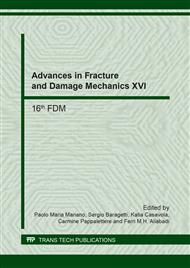p.59
p.63
p.67
p.71
p.75
p.79
p.83
p.87
p.91
Experimental Study of Fatigue Crack Initiation and Strain Evolution around a Micro-Void by In Situ SEM and Digital Image Correlation
Abstract:
Fatigue crack initiation stage occupies a large proportion of total fatigue life in modern engineering materials and structures which are often designed under lower service loading conditions. In this paper, the fatigue crack initiation behavior from a micro-void in a small-scale specimen was studied in-situ in SEM. Surface morphologies were monitored in-situ and images were taken during interrupted tests at selected number of cycles, and displacement and strain map around the void was calculated based on digital image correlation (DIC) technique. The results indicated that the strain evolution near the micro-void could be divided into stages, before crack initiation. The strain increasing rate was fast in the early stage and slower in the second stage. A critical cyclic strain value for fatigue crack initiation from the micro-void was obtained around 9%, and was believed to be the dominant factor for early stage of fatigue damage.
Info:
Periodical:
Pages:
75-78
Citation:
Online since:
September 2017
Authors:
Price:
Сopyright:
© 2017 Trans Tech Publications Ltd. All Rights Reserved
Share:
Citation:


